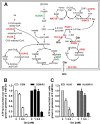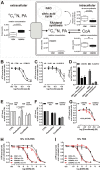Rewired metabolism in drug-resistant leukemia cells: a metabolic switch hallmarked by reduced dependence on exogenous glutamine
- PMID: 25697355
- PMCID: PMC4375488
- DOI: 10.1074/jbc.M114.618769
Rewired metabolism in drug-resistant leukemia cells: a metabolic switch hallmarked by reduced dependence on exogenous glutamine
Abstract
Cancer cells that escape induction therapy are a major cause of relapse. Understanding metabolic alterations associated with drug resistance opens up unexplored opportunities for the development of new therapeutic strategies. Here, we applied a broad spectrum of technologies including RNA sequencing, global untargeted metabolomics, and stable isotope labeling mass spectrometry to identify metabolic changes in P-glycoprotein overexpressing T-cell acute lymphoblastic leukemia (ALL) cells, which escaped a therapeutically relevant daunorubicin treatment. We show that compared with sensitive ALL cells, resistant leukemia cells possess a fundamentally rewired central metabolism characterized by reduced dependence on glutamine despite a lack of expression of glutamate-ammonia ligase (GLUL), a higher demand for glucose and an altered rate of fatty acid β-oxidation, accompanied by a decreased pantothenic acid uptake capacity. We experimentally validate our findings by selectively targeting components of this metabolic switch, using approved drugs and starvation approaches followed by cell viability analyses in both the ALL cells and in an acute myeloid leukemia (AML) sensitive/resistant cell line pair. We demonstrate how comparative metabolomics and RNA expression profiling of drug-sensitive and -resistant cells expose targetable metabolic changes and potential resistance markers. Our results show that drug resistance is associated with significant metabolic costs in cancer cells, which could be exploited using new therapeutic strategies.
Keywords: Drug Resistance; Glutamine; Glycolysis; Leukemia; Mass Spectrometry (MS); Metabolism; Metabolomics; Transcriptomics; β-Oxidation.
© 2015 by The American Society for Biochemistry and Molecular Biology, Inc.
Figures






Similar articles
-
Exercise testing in metabolic myopathies.Phys Med Rehabil Clin N Am. 2012 Feb;23(1):173-86, xii. doi: 10.1016/j.pmr.2011.11.011. Epub 2011 Dec 11. Phys Med Rehabil Clin N Am. 2012. PMID: 22239882 Review.
-
Activity and mRNA levels of enzymes involved in hepatic fatty acid synthesis and oxidation in mice fed conjugated linoleic acid.Biochim Biophys Acta. 2003 Apr 8;1631(3):265-73. doi: 10.1016/s1388-1981(03)00038-6. Biochim Biophys Acta. 2003. PMID: 12668178
-
MSC-induced lncRNA HCP5 drove fatty acid oxidation through miR-3619-5p/AMPK/PGC1α/CEBPB axis to promote stemness and chemo-resistance of gastric cancer.Cell Death Dis. 2020 Apr 16;11(4):233. doi: 10.1038/s41419-020-2426-z. Cell Death Dis. 2020. PMID: 32300102 Free PMC article.
-
New fatty acid oxidation inhibitors with increased potency lacking adverse metabolic and electrophysiological properties.Bioorg Med Chem Lett. 2004 Jan 19;14(2):549-52. doi: 10.1016/j.bmcl.2003.09.093. Bioorg Med Chem Lett. 2004. PMID: 14698201
-
beta-oxidation - strategies for the metabolism of a wide variety of acyl-CoA esters.Biochim Biophys Acta. 2000 Apr 12;1484(2-3):117-28. doi: 10.1016/s1388-1981(00)00013-5. Biochim Biophys Acta. 2000. PMID: 10760462 Review.
Cited by
-
Prediction of prognosis and immunotherapy response of amino acid metabolism genes in acute myeloid leukemia.Front Nutr. 2022 Dec 22;9:1056648. doi: 10.3389/fnut.2022.1056648. eCollection 2022. Front Nutr. 2022. PMID: 36618700 Free PMC article.
-
Effects of the Autophagy-Inhibiting Agent Chloroquine on Acute Myeloid Leukemia Cells; Characterization of Patient Heterogeneity.J Pers Med. 2021 Aug 10;11(8):779. doi: 10.3390/jpm11080779. J Pers Med. 2021. PMID: 34442423 Free PMC article.
-
miR-125b regulates differentiation and metabolic reprogramming of T cell acute lymphoblastic leukemia by directly targeting A20.Oncotarget. 2016 Nov 29;7(48):78667-78679. doi: 10.18632/oncotarget.12018. Oncotarget. 2016. PMID: 27637078 Free PMC article.
-
Metabolic Reprogramming of Chemoresistant Cancer Cells and the Potential Significance of Metabolic Regulation in the Reversal of Cancer Chemoresistance.Metabolites. 2020 Jul 16;10(7):289. doi: 10.3390/metabo10070289. Metabolites. 2020. PMID: 32708822 Free PMC article. Review.
-
The Hepatic Microenvironment Uniquely Protects Leukemia Cells through Induction of Growth and Survival Pathways Mediated by LIPG.Cancer Discov. 2021 Feb;11(2):500-519. doi: 10.1158/2159-8290.CD-20-0318. Epub 2020 Oct 7. Cancer Discov. 2021. PMID: 33028621 Free PMC article.
References
-
- Haffner M. C., Mosbruger T., Esopi D. M., Fedor H., Heaphy C. M., Walker D. A., Adejola N., Gürel M., Hicks J., Meeker A. K., Halushka M. K., Simons J. W., Isaacs W. B., De Marzo A. M., Nelson W. G., Yegnasubramanian S. (2013) Tracking the clonal origin of lethal prostate cancer. J. Clin. Investig. 123, 4918–4922 - PMC - PubMed
Publication types
MeSH terms
Substances
LinkOut - more resources
Full Text Sources
Miscellaneous

